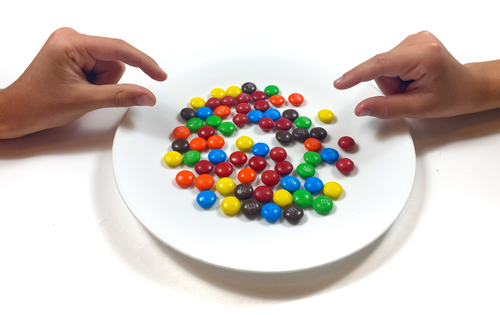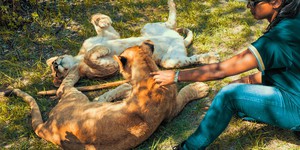Summary
Introduction
Have you ever wondered how predators, like wolves, lions, and hawks, are able to find their prey? And what can an animal do to stay off of a hunter's menu? To survive, some animals have developed specific camouflage tactics to fool their predators. One strategy some animals use is to look very similar to other animals that are poisonous or that the predator doesn't like to eat. This camouflage tactic is called mimicry. In this science activity, you will be the hungry predator and you will hunt for M&M's candies. But it may not be as easy as it sounds — some candies might not be what they seem! Will you be able to avoid picking the wrong ones? To find out, work up an appetite and go hunting for some candy!Materials
- Plain M&M's candies (20 of each color). Make sure 10 red and 10 yellow M&M's are included in the mix.
- Skittles (10 red and 10 yellow)
- Plastic bags (2)
- Metal pie tin or sturdy white paper plate
- Timer or stopwatch
- Volunteer predators (kids) who like to eat M&M's (2–4)
 Image Credit: Svenja Lohner, Science Buddies / Science Buddies
Image Credit: Svenja Lohner, Science Buddies / Science Buddies
Prep Work
- Everyone should wash their hands so that the candies can stay germ-free and be enjoyed later.
- Prepare two plastic bags with M&M's. Place 10 M&M's of each color into each bag. This means you should have two plastic bags with 10 yellow, 10 blue, 10 green, 10 brown, 10 red, and 10 orange M&M's candies in it (making a total of 60 candies in each bag). The M&M's represent different kinds of animals in the wild.
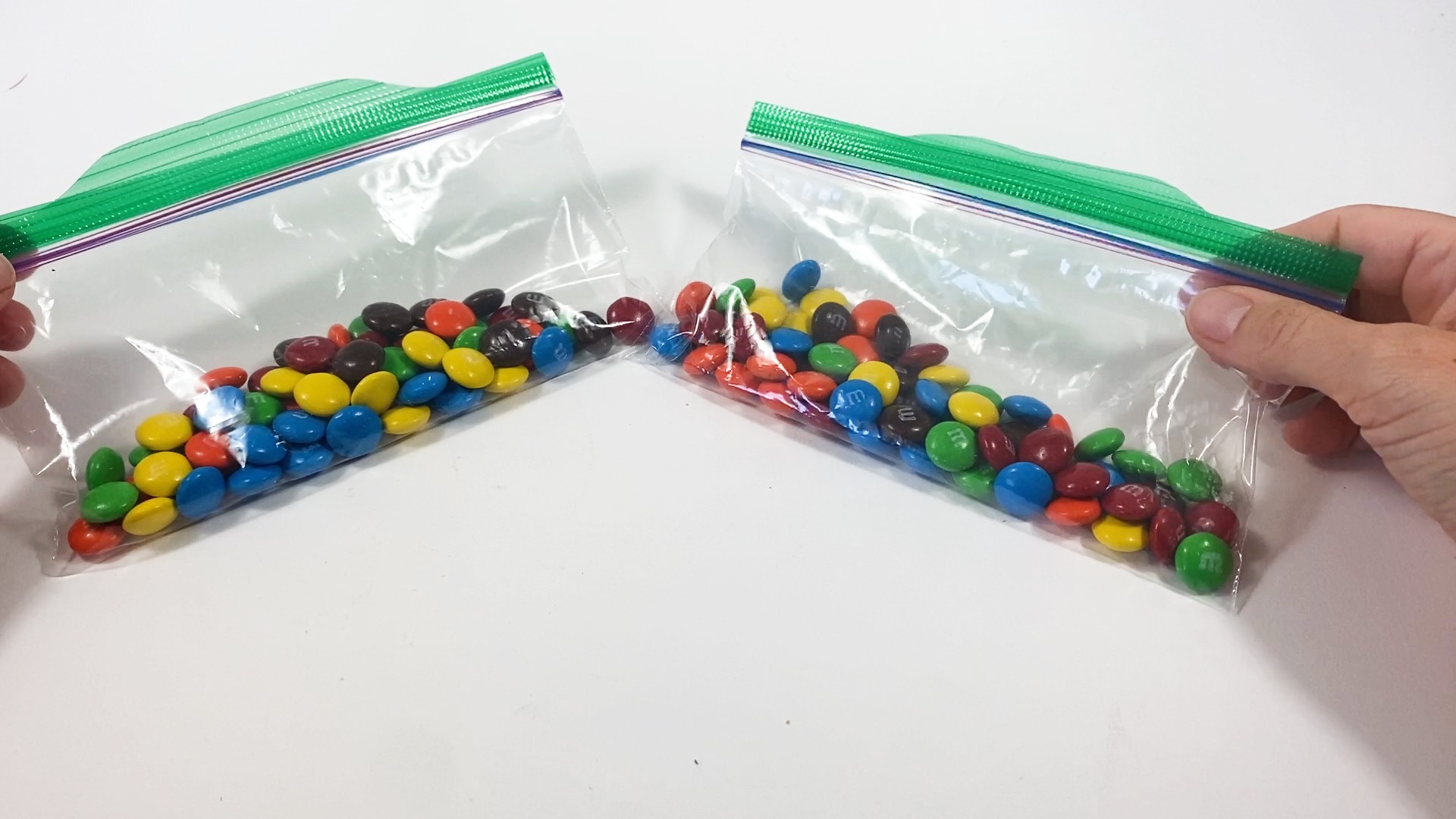 Image Credit: Svenja Lohner, Science Buddies / Science Buddies
Image Credit: Svenja Lohner, Science Buddies / Science Buddies
- Mix 10 red Skittles to one of the bags with M&M's. The red Skittles represent poisonous animals that the predator does not want to eat.
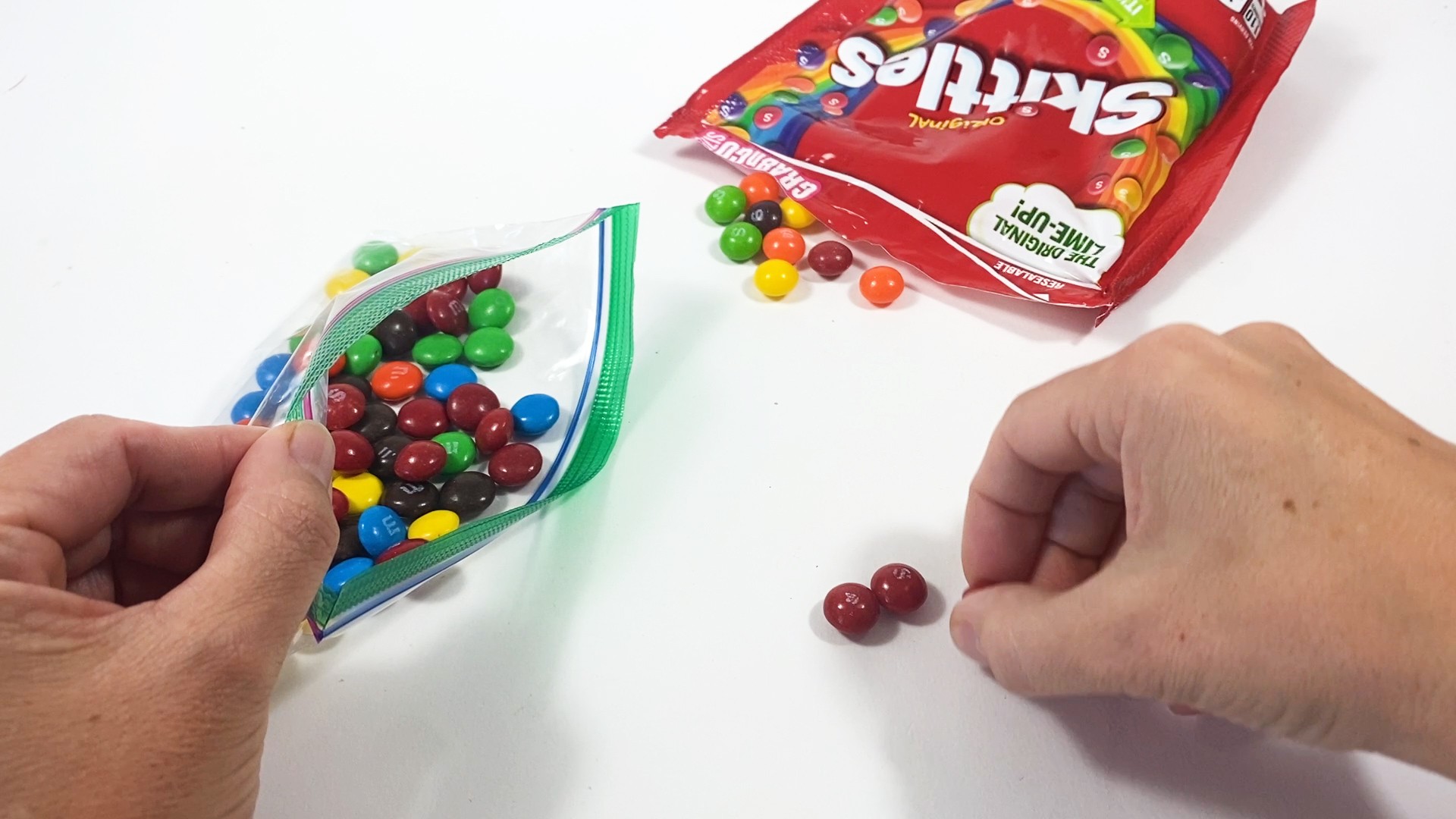 Image Credit: Svenja Lohner, Science Buddies / Science Buddies
Image Credit: Svenja Lohner, Science Buddies / Science Buddies
- Mix 10 yellow Skittles to the second bag with M&M's. The yellow Skittles also represent poisonous animals that the predator does not want to eat.
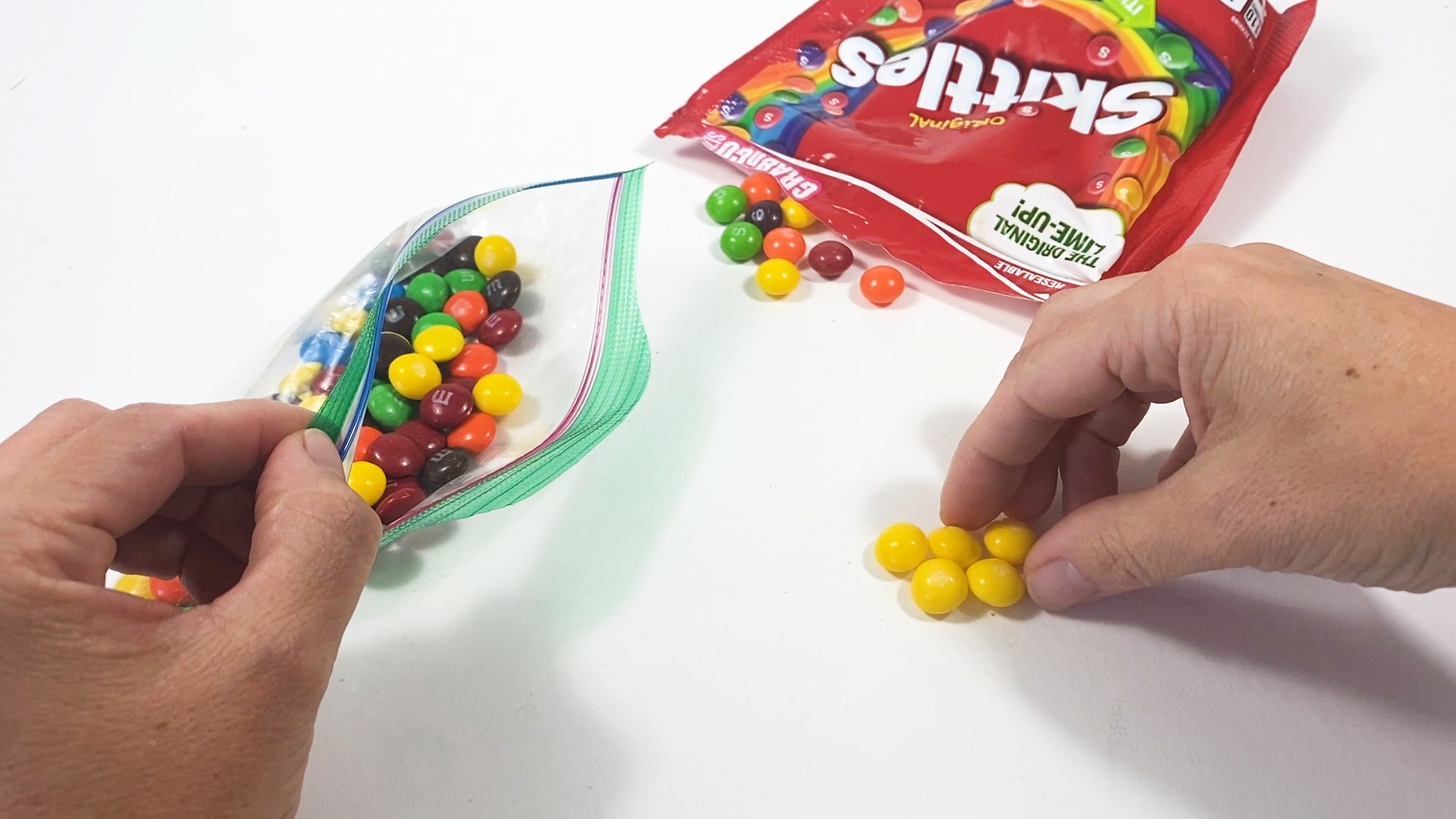 Image Credit: Science Buddies
Image Credit: Science Buddies
Instructions
- Explain to your pack of two to four volunteer "predators" that they should pretend to be M&M's birds. The M&M's are their prey. They should make a "beak" using their pointer finger and thumb for collecting M&M's animals. Explain that they will have 20 seconds to use their beak to quickly pick up M&M's and quickly put them in their other hand. To encourage the volunteers to be fast, tell them that when they are done with the activity, they can eat the same number of candies as they picked up. But they should not eat the candies until you are all done with the activity.
- Also tell the volunteers that they should avoid picking up any red or yellow Skittles animals because the Skittles animals are poisonous and make the M&M's birds sick.How do you think the mimicry tactic will work out for the red and yellow M&M's?
- After explaining these rules, pour the first prepared bag of M&M's with the red Skittles into a metal pie tin or sturdy paper plate. There should now be 10 M&M's of each color and 10 red Skittles on the plate. Put the pie tin in the middle of your group of M&M's birds. Make sure everyone can reach the pie tin.Which M&M's do you think have the best chance of survival?
- Tell the predators that you will now start the 20 second timer, so they can start hunting their prey. Remind them to avoid the red or yellow Skittles animals. Then set your timer for 20 seconds. Say "Go!" and start the timer. When the timer beeps, make sure everyone stops picking up M&M's.
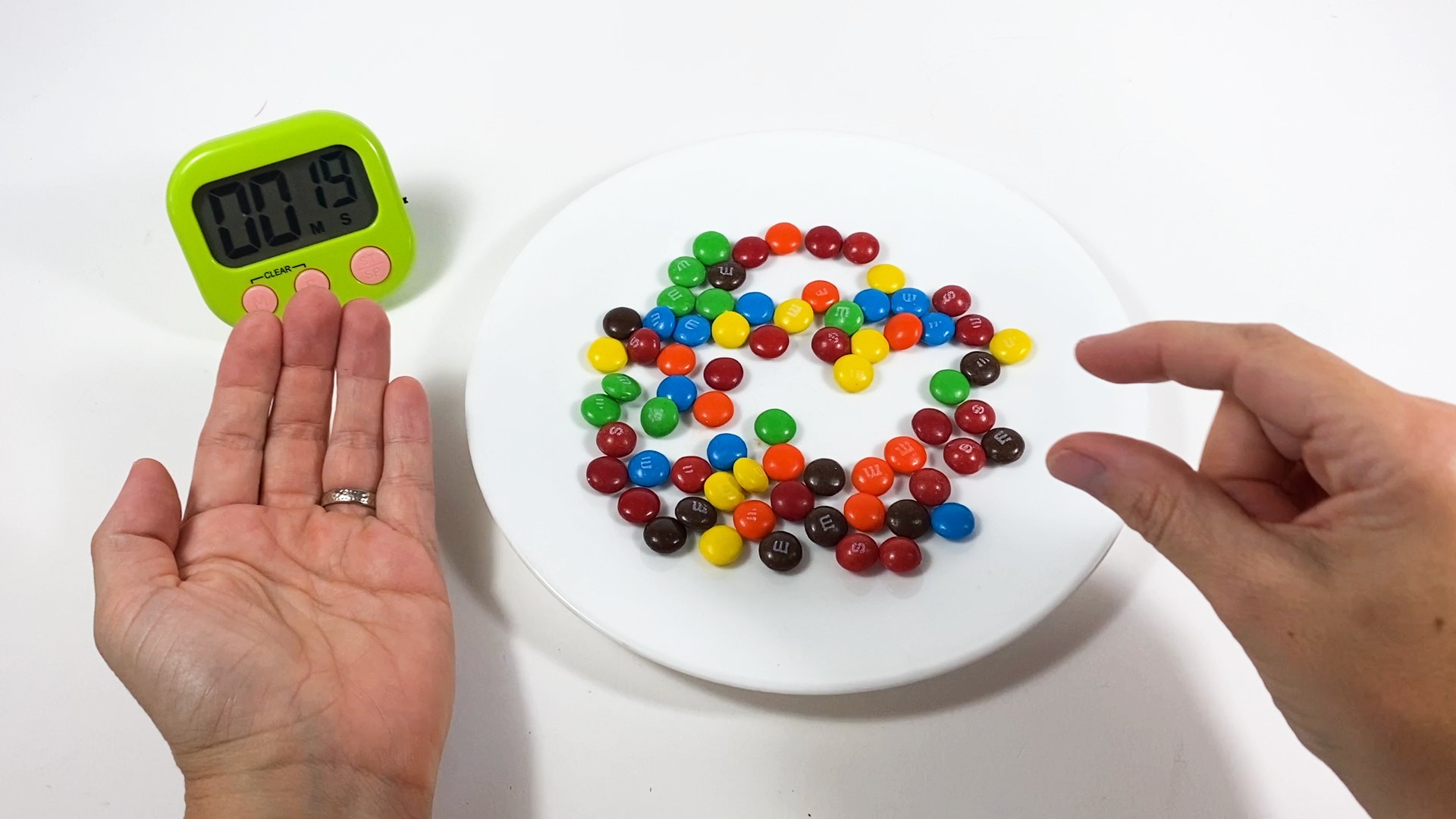 Image Credit: Svenja Lohner, Science Buddies / Science Buddies
Image Credit: Svenja Lohner, Science Buddies / Science Buddies
- Count the number of each M&M's color that each person collected. Also count any Skittles that were picked up.Which M&M color was the least-picked one? What do you think this has to do with camouflage?
- Put all of the M&M's and Skittles back in the bag you prepared them in (including M&M's that people picked).
- Repeat the 20-second M&M hunt but this time use the prepared M&M bag with the yellow Skittles instead of the red ones.Which M&M color was the least-picked one this time? Can you explain what this has to do with camouflage?
Cleanup
What Happened?
At a glance, it is difficult to tell M&M's and Skittles candies apart. Skittles are less flat than M&M's, but their red and yellow colors are very similar. This is why if you tell someone to avoid picking a certain color Skittles, then, if they are picking the candies quickly, they are less likely to pick M&M's that are the same color as those Skittles. Those M&M's "prey" are being camouflaged by having the same color and similar shape as the Skittles. Consequently, in the experiment with the red Skittles, the red M&M's should have been picked less often than any other M&M's candy, and the same goes for the experiment with the yellow Skittles — the yellow M&M's should have been picked the least often.
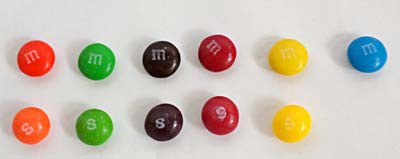 Image Credit: Teisha Rowland, Science Buddies / Science Buddies
Image Credit: Teisha Rowland, Science Buddies / Science Buddies
Digging Deeper
It can be hard to survive in the wild. Most animals are hunted by other animals. For example, some types of bats hunt insects. But bats are also hunted by owls, hawks, and snakes. So bats are sometimes predators and sometimes prey. A species (type) of animal can change over time. This often takes many generations. Animal species change to increase their chance of survival. Some species develop protective features on their bodies. Two examples are porcupine quills and armadillo armor. Other animals have skin coatings that taste bad or are poisonous. Some animals change in ways that make them blend into their surroundings or allow them to fool predators by their appearance. This is called camouflage.
There are several camouflage tactics that animals use. One of them is called mimicry. Animals that use mimicry look like other animals that taste bad or are dangerous or poisonous. Viceroy butterflies, shown in the picture below on the left, are an example of an animal that has evolved mimicry. Their wing color and pattern look almost exactly like Monarch butterfly wings, as you can see in the middle picture below. Since Monarch butterflies are poisonous and taste bad to many predators, predators avoid eating any animals that look like them. Other animals use mimicry to look larger than they really are. Several moths and butterflies have designs on their wings that look like the eyes of larger animals. For example, the owl butterfly, shown in the picture below on the right, has big round spots on its wings. When the wings are spread, these spots look like owl eyes. Predators are fooled into thinking they are looking at an owl’s face instead of a butterfly. So, they leave the butterfly alone.

Ask an Expert
For Further Exploration
- Adaptation and evolution happen over several generations. Try testing this by mixing the red Skittles animals to your prepared bag of M&M's animals in the pie tin. After a 20-second round of M&M predation, as described in this activity, double the number of M&M's that are left by adding a colored M&M to match the color of each remaining M&M's candy. For instance, if there are four red and two brown M&M's, then add four more red and two more brown M&M's. Then repeat another round of predation. How many rounds does it take to remove all of the M&M's of one color?
- Find pictures of different camouflaged animals, such as a katydid that looks like a leaf on a tree branch, or a chameleon that is blending in with its surroundings. After finding several pictures of different camouflaged animals, show them to some volunteers and time how long it takes the volunteers to spot each animal. Do some camouflage tactics work better than others, making volunteers take longer to spot the animal?
- You could try repeating this activity using different types of candy. How easy is it for M&M's birds to catch their prey when the habitat is made using candies of a different shape, such as Nerds candies, or candies that are both different in shape and multi-colored, like Candy Corns?


